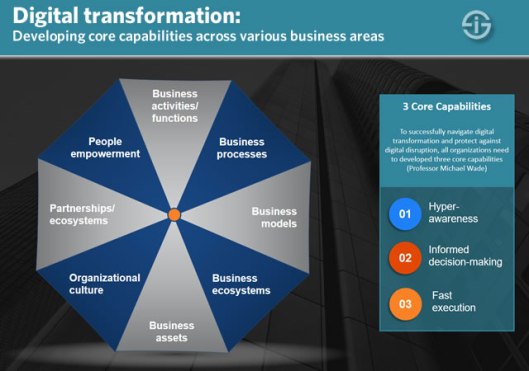Tags
Agile, Agility, Business Asset Management, Business Model, Business process, Culture, Departments, Digital Business, Ecosystem
Thinking and planning through the evolution of your digital business requires some holistic and strategic thinking. It is a core function of the C-Suite and the CEO is accountable to the Board of Directors for the results. So, what are some of the areas to consider?
- Business departments/functions: marketing, operations, human resources, administration, customer service, etc.
- Business processes: one or more connected operations, activities and sets to achieve a specific business goal, whereby business process management, business process optimization and business process automation come into the picture. Business process optimization is essential in digital business strategies and in some industries and cases is essentially customer-facing today, whereas in others internal goals come first in initial stages.
- Business models: how businesses function, from the go-to-market approach and value proposition to the ways it seeks to make money and effectively transforms its core business, tapping into novel revenue sources and approaches, sometimes even dropping the traditional core business after a while.
- Business ecosystems: the networks of partners and stakeholders, as well as contextual factors affecting the business such as regulatory or economic priorities and evolutions. New ecosystems are built between companies with various background upon the fabric of digital business, information, whereby data and actionable intelligence become innovation assets.
- Business asset management: whereby the focus lies on traditional assets but, increasingly, on less ‘tangible’ assets such as information and customers (enhancing customer experience is a leading goal of many digital business “projects” and information is the lifeblood of business, technological evolution and of any human relationship). Both customers and information need to be treated as real assets in all perspectives.
- Organizational culture, whereby there is a clear customer-centric, agile and hyper-aware goal which is achieved by acquiring core competencies across the board in areas such as digital maturity, leadership, knowledge worker silos and so forth.
- Ecosystem and partnership models, with among others a rise of co-opetive, collaborative, co-creating and, last but not lost, entirely new business ecosystem approaches, leading to new business models and revenue sources.
- Customer, worker and partner approaches. Digital business strategy puts people and strategy before technology. The changing behavior, expectations and needs of any stakeholder are crucial. This is expressed in many change sub-projects whereby customer-centricity, user experience, worker empowerment, new workplace models, changing channel partner dynamics etc. (can) all come in the picture. It’s important to note that digital technologies never are the sole answer to tackle any of these human aspects, from worker satisfaction to customer experience enhancement. People involve, respect and empower other people in the first place, technology is an additional enabler and part of the equation of choice and fundamental needs.
This list is not exhaustive and de facto the several mentioned aspects are connected and overlap. We do look at some less business-related ‘digital evolution’ phenomena and at so-called disruptions but the focus is on the business, which by definition means a holistic digital strategic view whereby aspects such as customer experience, technological evolutions and innovation with a clear purpose, instead of a buzzword, are crucial elements.
So, the evolution of your digital business strategy is certainly not just about disruption or technology alone. It is even not just about transforming for a digital age. If it were the latter, one has to realize that this digital age exists since quite some time and is relatively vague.

